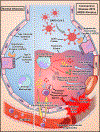Acute Respiratory Distress Syndrome
- PMID: 33016981
- PMCID: PMC7854846
- DOI: 10.1097/ALN.0000000000003571
Acute Respiratory Distress Syndrome
Abstract
Acute Respiratory Distress Syndrome (ARDS) is defined as the rapid onset of non-cardiogenic pulmonary edema resulting in respiratory failure and hypoxemia. Efforts over the past 25 years, such as those of the ARDS and Prevention and Early Treatment of Acute Lung Injury (PETAL) Networks, have demonstrated a praiseworthy collaboration to further optimize the management of ARDS. However, improvements have been only moderate and ARDS remains a leading cause of mortality in the perioperative and critical care setting. Recently, the significant morbidity and mortality of ARDS have been emphasized by its high incidence in Coronavirus Disease 2019 (COVID-19) patients. A major hurdle to reducing ARDS mortality is that current treatment is limited to preventive measures – such as the use of lung-protective ventilation. Therapeutic approaches targeting the underlying inflammatory lung disease are areas of intensive research, but have not been clinically implemented. Nevertheless, basic science and clinical research efforts that are aimed at identifying novel treatment approaches and further improving outcomes for ARDS are ongoing. Here, we review evidence-based management approaches for ARDS, while highlighting those being investigated or heavily utilized in ARDS associated with COVID-19.
Conflict of interest statement
Figures


References
-
- Ranieri VM, Rubenfeld GD, Thompson BT, Ferguson ND, Caldwell E, Fan E, Camporota L, Slutsky AS, Force ADT: Acute respiratory distress syndrome: the Berlin Definition. JAMA 2012; 307: 2526–33 - PubMed
-
- Bellani G, Laffey JG, Pham T, Fan E, Brochard L, Esteban A, Gattinoni L, van Haren F, Larsson A, McAuley DF, Ranieri M, Rubenfeld G, Thompson BT, Wrigge H, Slutsky AS, Pesenti A, Investigators LS, Group ET: Epidemiology, Patterns of Care, and Mortality for Patients With Acute Respiratory Distress Syndrome in Intensive Care Units in 50 Countries. JAMA 2016; 315: 788–800 - PubMed
-
- Wu C, Chen X, Cai Y, Ja Xia, Zhou X, Xu S, Huang H, Zhang L, Zhou X, Du C, Zhang Y, Song J, Wang S, Chao Y, Yang Z, Xu J, Zhou X, Chen D, Xiong W, Xu L, Zhou F, Jiang J, Bai C, Zheng J, Song Y: Risk Factors Associated With Acute Respiratory Distress Syndrome and Death in Patients With Coronavirus Disease 2019 Pneumonia in Wuhan, China. JAMA Internal Medicine 2020 - PMC - PubMed
-
- Zhou F, Yu T, Du R, Fan G, Liu Y, Liu Z, Xiang J, Wang Y, Song B, Gu X, Guan L, Wei Y, Li H, Wu X, Xu J, Tu S, Zhang Y, Chen H, Cao B: Clinical course and risk factors for mortality of adult inpatients with COVID-19 in Wuhan, China: a retrospective cohort study. Lancet 2020; 395: 1054–1062 - PMC - PubMed
Publication types
MeSH terms
Substances
Grants and funding
- T32 GM120011/GM/NIGMS NIH HHS/United States
- P01 HL114457/HL/NHLBI NIH HHS/United States
- R01 HL109233/HL/NHLBI NIH HHS/United States
- UL1 TR003167/TR/NCATS NIH HHS/United States
- R01 DK097075/DK/NIDDK NIH HHS/United States
- R01 DK109574/DK/NIDDK NIH HHS/United States
- R01 HL119837/HL/NHLBI NIH HHS/United States
- T32 HL007747/HL/NHLBI NIH HHS/United States
- R01 HL133900/HL/NHLBI NIH HHS/United States
- R01 DK122796/DK/NIDDK NIH HHS/United States
- R01 HL098294/HL/NHLBI NIH HHS/United States
- R01 DK082509/DK/NIDDK NIH HHS/United States
LinkOut - more resources
Full Text Sources
Medical
Miscellaneous

